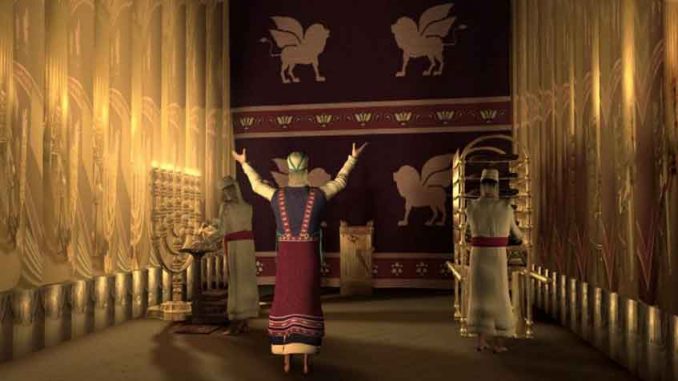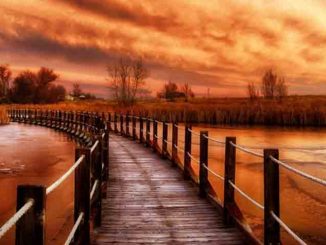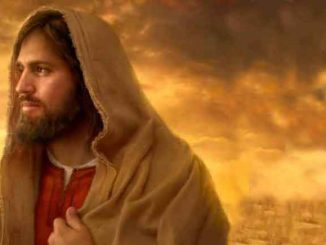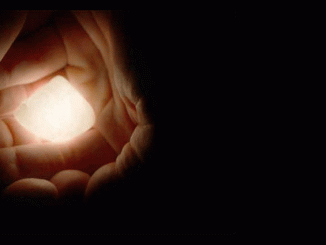

When Moses came down from Sinai, he brought the charge to build a tabernacle «And let them make me a sanctuary; that I may dwellamong them.» ( Exodus 25: 8 ). In that tabernacle would be the presence of Jehovah. He declares this when he says to them, «And there I will meet with the children of Israel, and the tabernacle shall be sanctified by my glory.» ( 29:43) ). There has not been a moment in history with such an obvious closeness between God and man. But at the same time there was uncertainty next to the veil
The main element of the tabernacle was the veil. The veil was 4.60 wide by 4.60 high. I was not split in half. Once a year the priest went alone through the side of the Holy of Holies, to offer a sacrifice for the sins of himself and those of the people.
When the Jerusalem temple was built, the veil was ten centimeters and 18 meters high. It was a tenuous and dense separation at the same time. It was possible to separate it but not to cross it.
The teaching of both was the same: the separation of its presence is not an insurmountable wall, it is of a flexible, ductile nature, It is of a constitution different from the walls and the ground. It is not a solid separation. It can be unrolled and folded. The veil has embroidered two angels that announce and at the same time guard the presence of Jehovah. It is a very significant element of the past and present temple.
The torn veil
The veil of that temple was torn from top to bottom in the moments when the redeemer expired on the cross. Jesus Christ, is our high priest, «For such an high priest became us, who is holy, harmless, undefiled, separate from sinners, and made higher than the heavens; Who needeth not daily, as those high priests, to offer up sacrifice, first for his own sins, and then for the people’s: for this he did once, when he offered up himself.« ( Hebrews 7: 26-27 )
When he offered himself as a sacrifice, as a high priest, the law was fulfilled. For he was without blemish and in his atonement he filled justice, leaving man free from the chains of sin. The human being no longer needed an intermediary in the presence of Jehovah behind the veil. We were enabled to receive the word of God personally and directly, through the grace of the savior.
 The veil of the temple hid God from sight. The one on the other side could not see or hear it. I can not imagine a more accurate representation of reality.We do not see or touch God and we can not go through that veil. Whether we like it or not, the temple as well as the reality outside contain a greater or lesser principle of uncertainty. Why not expose the most holy place, the ark and the space between the two cherubs of his offertory, where the high priest presented himself before Jehovah?… because the reality is that, it is veiled.
The veil of the temple hid God from sight. The one on the other side could not see or hear it. I can not imagine a more accurate representation of reality.We do not see or touch God and we can not go through that veil. Whether we like it or not, the temple as well as the reality outside contain a greater or lesser principle of uncertainty. Why not expose the most holy place, the ark and the space between the two cherubs of his offertory, where the high priest presented himself before Jehovah?… because the reality is that, it is veiled.
However there is another veil and this time it is not braided linen.
The veil in Liberty
The Prophet Joseph Smith, before that royal veil, pleads «O God, where art thou? And where is the pavilion that covereth thy hiding place?( D & C 121: 1 ) and later on he pleads, «let thy pavilion be taken up; let thy hiding place no longer be covered; let thine ear be inclined; let thine heart be softened, and thy bowels moved with compassion « ( 4 )

Contrary to the Christian churches, where the entire altar is a representation of the heavens, in those beautiful carved altarpieces, or artistic paintings of great value. In the tabernacle and in the temple, there are no images of God but the uncertainty of his presence before our senses.
That is why I believe that this principle of uncertainty before the veil is necessary to know God. Even when this principle is accompanied by faith and hope, it remains «an imperfect knowledge of things» That principle is not unusual in modern physics, where Werner Heisenberg officiates in his ministry.
I used to play with a nephew as a young man in a dry stream near my house. I had fun placing it on an edge and asking it to jump. The distance required me to take it up in the air so it would not fall. There was no danger, but for a child it was difficult to trust that he would hold it. I provoked a fairly clear uncertainty principle.
The veil of the temple
The veil of the temple of Solomon and the veil before which the prophet prayed in prayer are necessary. They provoke a contradiction in our mind, an imbalance. This is necessary to have faith. To fall into a contradiction with the facts. This is the uncertainty principle as we approach the concreteness of the revelations.
The states of doubt are sacred moments, they are not a sign of weakness. Certainty often discourages us from removing the veil in its corner.
Nephi hears his brothers complain about not understanding the words of his father Lehi and asks them.
«And I said unto them: Have ye inquired of the Lord?
And they said unto me: We have not; for the Lord maketh no such thing known unto us. «( 1 Nephi 15: 8-9 )
Approaching the veil
Lifting the veil supposes contradicting our senses and even enter into dark areas of our soul. Kneeling in a forest, is the last resort of someone confused, someone who does not find an answer in the certainty of all those around him. The veil leads us to the path of folly before the world.

Israel, did not understand Jehovah well. It was a God difficult to contain. They trusted in the temple, their house. Its walls, its columns, the richness of its interior. The walls, stairways, sacred rites, the officiants. All this conformed in their minds an accurate and stable order. They could build a nation around that temple. That was for them a certainty.
But Jehovah was willing to raze his house. They could not contain it in a building.
The uncertainty next to the veil
Desde detrás del velo escuchamos hablar a cada uno.
“ Behold, I say unto you, David, that you have feared man and have not relied on me for strength as you ought. But your mind has been on the things of the earth more than on the things of me, your Maker…” (D & C 30:1-2)




Be the first to comment